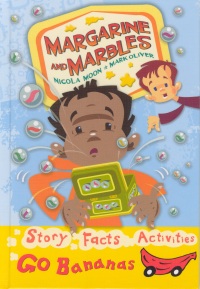| ________________
CM . . .
. Volume XII Number 16 . . . .April 14, 2006
excerpt:
As children make the transition form picture books to chapter books, titles from the “Red Go Bananas” series can help them with the move. As with other books in this series, Margarine and Marbles has three parts: a storyline built around a science-based problem, a section of factual information connected to the story’s problem, and a concluding activity which allows children to apply aspects of the science learned. In Margarine and Marbles, forces, friction and movement are at the book’s science focus. The story opens with the discovery of a large wooden crate which is obstructing the street on which Tom lives. The children try to figure out how to move this huge crate, and they enlist the help of everyone on the street, but their attempts first to push it and then to pull it using ropes do not work. The children decide they need to make the road slippery and accidentally spill some margarine and marbles. The accident does make for a somewhat slippery situation, but it is still not enough to make the crate move. Then they find a better idea in a book which shows some men from long ago moving a huge stone on wooden logs. With the help of a forklift from a nearby garage, the crate is lift sufficiently to permit some round fenceposts from a fence under construction to be slid under the crate. Then, with some pushing, the crate begins to moves, but it moves too well and rams into a tree, the collision causing the crate to break open. Inside, there is a baby elephant. At the same time, a lady from the wildlife park arrives to claim the misdelivered crate. The children are rewarded by being given free tickets to visit the wildlife park. Following the story, Moon provides some brief factual information about “forces” and “friction,” and then children are invited to put force into action by creating their own bowling game with discarded plastic bottles and using a tennis ball for the bowling ball. Recommended. Bev Dunlop, who lives in Oakbank, MB, is a Stay-at-Home-Mom and part-time helper at Oakbank Elementary School.
To comment
on this title or this review, send mail to cm@umanitoba.ca.
Copyright © the Manitoba Library Association. Reproduction for personal
use is permitted only if this copyright notice is maintained. Any
other reproduction is prohibited without permission.
NEXT REVIEW |
TABLE OF CONTENTS FOR THIS ISSUE
- April 14, 2006.
AUTHORS |
TITLES |
MEDIA REVIEWS |
PROFILES |
BACK ISSUES |
SEARCH |
CMARCHIVE |
HOME |
